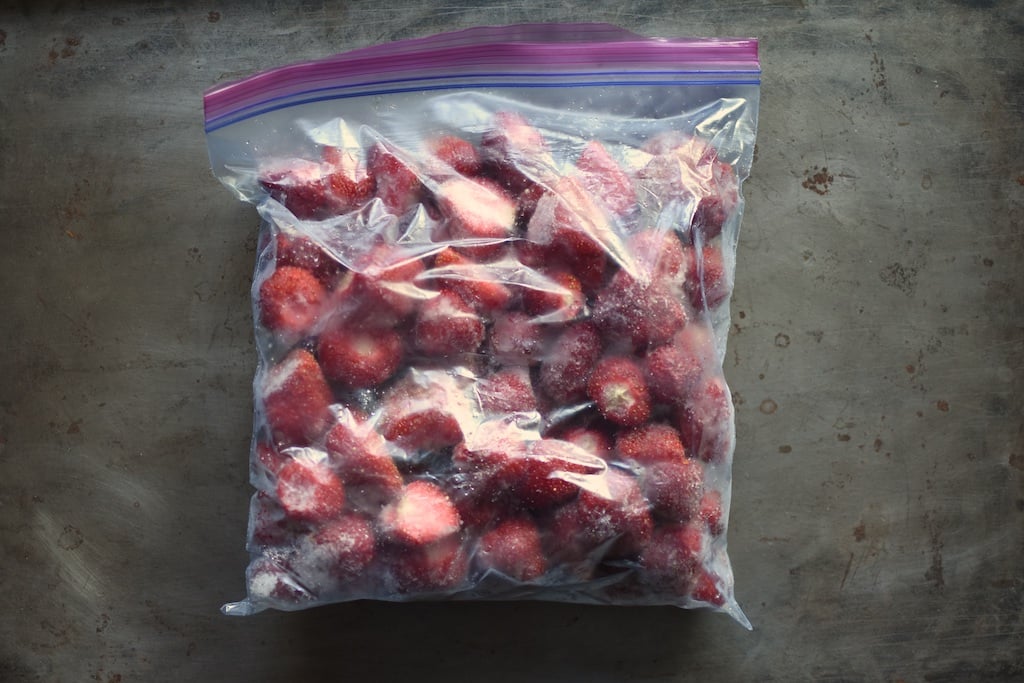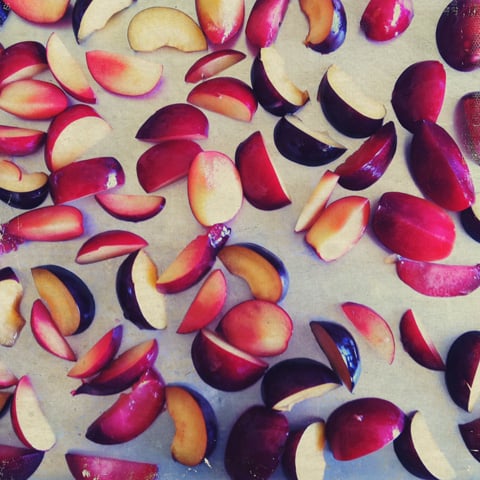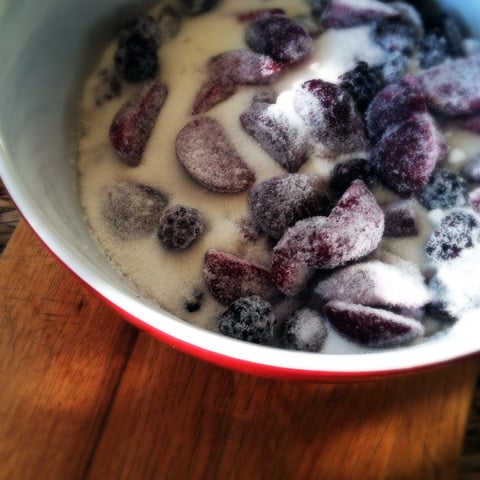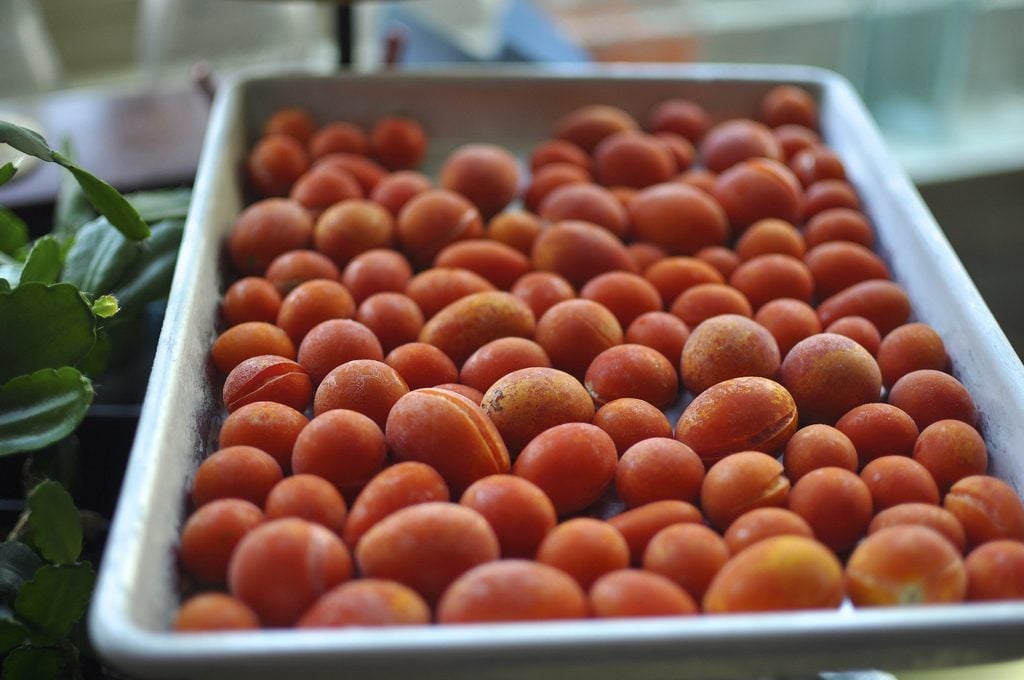Featured
- Get link
- X
- Other Apps
Making Jam from Frozen Fruit
My friend Shae has shut down her blog, Hitchhiking to Heaven. Before she took it offline, she offered up some of her old posts so that they can continue to live and be useful.

Last year, two things came into my life that changed the way I preserve fruit. One was an upright storage freezer, which now lives in the basement. The other was a Food Saver, which allows me to freeze fruit in vacuum sealed packages at the height of just-picked excellence, without the danger of ruin from stale air and freezer burn. (Even before the Food Saver, I’d started freezing summer fruit in this way, using heavy-duty freezer bags and sucking out the excess air through a straw or with my mouth — all of which is easier than it might sound.)
The ability to freeze good fruit is important to me, in part, because we spend the peak preserving month of August far away from home, at our cabin in Alaska. Just before we leave, I am slammed with pounds and pounds of berries and plums — more than I could sanely process, given everything else that’s going on. It’s a huge relief to be able to flash freeze, package, and tuck away the harvest to make jam later.

When I started to create jams with my frozen summer’s haul, I was of two minds: Mostly, I loved having the luxury of combining so many fruits. Opening the freezer to securely preserved strawberries, blackberries, raspberries, plums, and figs was like diving into a chest of colorful, edible art supplies. I had strawberries to blend with feijoas when the latter showed up in November. (I’ll be sure to post that recipe next fall when feijoas come in again. It was one of my favorite jams of the year.)
I made a luscious plum, strawberry, and ground cherry jam that I never would have thought of if I’d used up all those strawberries in June. The frozen plums — at least three different varieties – found their way into almost everything, lending a tart complexity and pectin boost to jams from October until just last week, when they finally ran out.

But I also felt guilty. Isn’t it cheating to make jam from frozen fruit? I let flavor decide that question. It’s all good jam. Because the fruit was frozen with care, at the very point where I would want it for jam making — some of it perfectly ripe and some of it just under — the difference in flavor was negligible to nonexistent. As Darina Allen says in her gorgeous book, Forgotten Skills of Cooking:
If you don’t want to spend your whole summer in the kitchen, the most practical approach is to freeze fruit in perfect condition in small, measured quantities, so that you can make jam as you need it throughout the year. Jam made from frozen fruit will taste infinitely fresher and more delicious than a six- or seven-month-old jam even if it is made in peak season.
So. Yes. You can make some damned fine jam from frozen fruit. Here, I thought I’d share a few tips and the method I like to use for jamming frozen fruit.
How to Make Jam From Frozen Fruit: Tips and Tricks
Start with the best. What goes into your jars is what you get out of them, so use the best fruit you can find. Depending on the type of fruit, you’ll want to freeze it at the peak of flavor or when it’s just a tad underripe. Hitting that peak of ripeness is critical for fruits like strawberries or figs, where a little bit to one side or the other makes all the difference between the jam you want and the one you don’t. With fruits like plums, blackberries, or raspberries, however, I like a mix of perfectly ripe and just under, for both the extra pectin and the extra pucker that the less ripe fruits provide.

Don’t get it wet. I pick over berries. I gently spot clean plums. I remove any bad bits from strawberries. But I don’t wash fruit before I freeze it. It’s all organic or foraged from unsprayed places. I pick it myself, or I know the people who do. I’m also going to boil the bejeezus out of it, so I don’t worry about skipping the wash. (As an aside, some professional jam makers I know and respect don’t wash their organic fruit before jamming it. That’s how I learned to stop doing it, myself. So if a professional jam maker jumped off a bridge, would I jump off a bridge, too? I suppose I might.)
Slice, dice, and weigh. Before you freeze the fruit, cut it to the size you think you’ll want it to be when you use it later, because you probably don’t want to mess around with trying to chop up plum halves or whole, huge strawberries after they’ve been frozen. If you want different textures for different jams, freeze multiple bags, each containing the size you’ll want. You may want to plan for bags of various weights, too. I prepped a lot of two- and three-pound bags, but found that I also loved having single-pound bags to play with.

Flash freeze first. You already know about this, right? It’s where you put the individual pieces of fruit on trays and freeze them until they’re just solid. Then you put the flash frozen fruit into freezer bags. This is how you avoid things like whole bricks made of blackberries. Do note that some fruits have special needs when it comes to freezing.
For example, I freeze figs in sugar syrup to retain color and texture. You can learn about that here. And you can find detailed information about freezing other types of fruit here. I have never, for example, frozen peaches, nectarines, or apricots because I haven’t had enough to warrant it. I’d want to check up on the particulars of freezing those or other fruits before attempting it for the first time.
Get the air out. Suck it out with a straw, give your freezer bags mouth to mouth, or get a Food Saver — just extract as much air as you can before you seal the bags. Then double check the seals.

Label it now or regret it later. On the outside of the freezer bag, jot down not just the fruit it contains, but the weight and the date you froze it, along with anything else you might want to remember, like where you picked it or who gave it to you. You’ll be glad you did. (For those of you who are ahead of me in the labeling game, would you please tell me your favorite way to label freezer bags? I write on them with a sharpie, but that makes reuse challenging. I travel with my toiletries in a bag labeled “Blackberries 2010.”)
Plan before you jam. Before you start pulling summer out of the freezer, think about what you want to make. It’s not a big deal — just some recipe notes so you can get in and out of the freezer quickly and not grab or thaw a lot more than you need.

Mmm . . . macerate. This is the best part. I start almost all my frozen fruit jams by macerating the fruit in sugar while it thaws. Doing it this way means you won’t end up with sad, pulpy bits of skin floating in a mess of juice. As the fruit thaws, the sugar nestles it and absorbs the liquid, so you end up with a mixture that is thick, bright, pectin rich (provided you’ve chosen a blend of fruits that provides enough pectin to make a successful jam, which is actually kind of hard not to do) and ready to cook.
I don’t add powdered or liquid pectin to my frozen fruit jams and I’ve not yet had a bad experience with one. In terms of how much sugar to use, that’s up to you and your fruit. I usually use 60%-75% of the weight of the fruit, depending on how much pectin it has (less pectin = more sugar) and how sweet it is to start.
Anyway, go clean out your freezer and make some jam. Because it’s spring and rhubarb is already upon us!
This piece was originally published on Hitchhiking to Heaven on March 25, 2012 and was written by Shae Irving.
Related Posts:
- Canning 101: How to Make Jam With Frozen Fruit + Apricot Meyer Lemon Jam
- What to do With Blackberries
- Canning 101: How to Swap Citric Acid for Lemon Juice and Vice Versa
* This article was originally published here
- Get link
- X
- Other Apps
Popular Posts
Interparfums FY 2022: record earnings as operating profit soars 33 percent
- Get link
- X
- Other Apps
CEO pay on the rise and pay gap widens despite cost-of living crisis
- Get link
- X
- Other Apps
Comments
Post a Comment